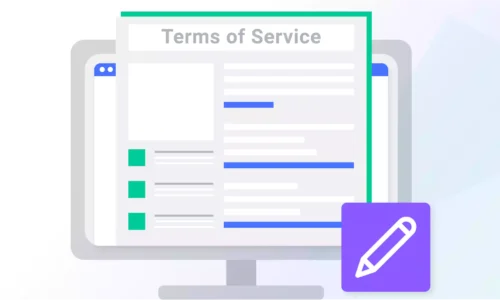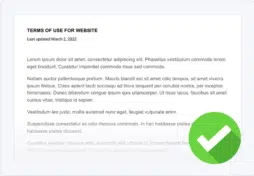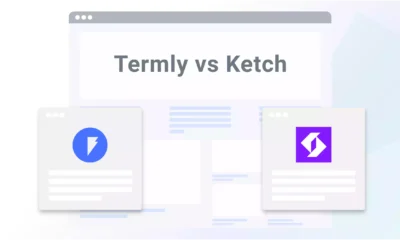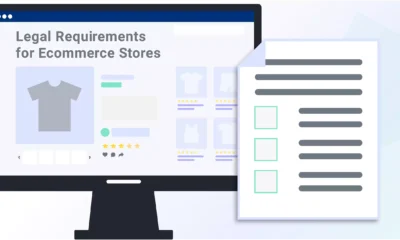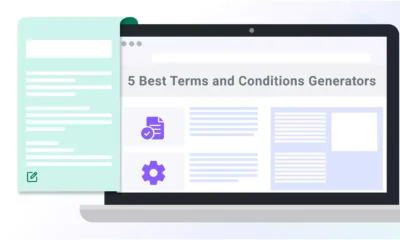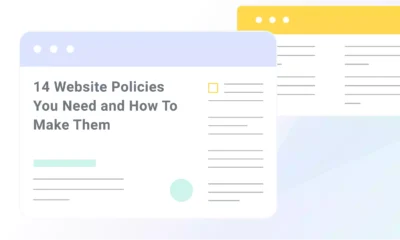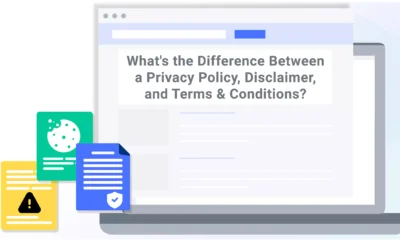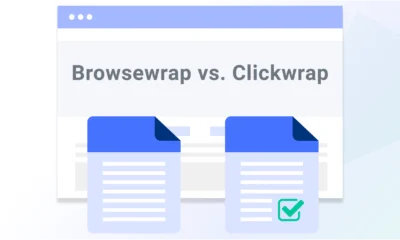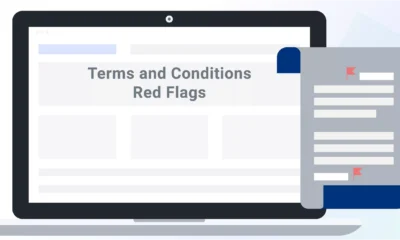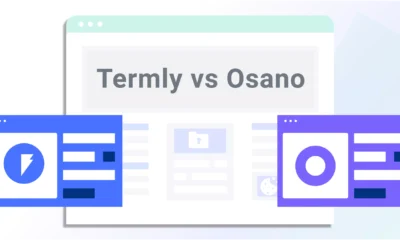A well-written terms of service agreement can set the rules and guidelines for your users, prohibit or restrict certain behaviors and activities, limit your liabilities, and establish your property rights.
In this article, we cover what a terms of service agreement is, why you need one, and look at some examples before presenting you with our free terms of service template.
- What Is a Terms of Service Agreement?
- Why You Need a Terms of Service for Your Website or App
- Most Common Clauses in a Terms of Service Agreement
- Where To Display Your Terms of Service
- How to Enforce Your Terms of Service Agreement
- Terms of Service Examples
- Tips for a Having a Good Terms of Service
- Why Use a Terms of Service Template?
- General Terms of Service Template [Example Text and Download]
- Terms of Service FAQ
- Summary
What Is a Terms of Service Agreement?
A terms of service sets all user rules, restrictions, and prohibited behaviors, and outlines your company’s liability limitations, property rights, and dispute resolutions.
You’ve probably seen some alternative titles for a terms of service agreement, like:
- Terms of Use
- Terms and Conditions
- ToS Agreement
- General Terms
- Terms
Despite the different names, these agreements are all the same.
No matter what you choose to call it, a generic terms of service policy can help protect your business from users who might break the law or cause harm to your website, app, or other users.
You can customize our free terms of service template below, including the title, so it works for you no matter if your own a:
- Dropshipping businesses
- Marketplace shop
- Retail store
- Ecommerce website or app
- Blog
- Forum
- Subscription-based platform
Why You Need a Terms of Service for Your Website or App
While a ToS agreement is not required by law, you need to post one on your website or app to help:
- Set your users’ expectations
- Protect your business from legal liabilities
- Maintain rights over your intellectual property
- Minimizes Disputes
- Establish trust and transparency with your users
Let’s go over the reasons for having a website or mobile app terms of service agreement in more detail.
Terms of Service Set Your Users’ Expectations
One of the purposes of a terms of service policy is to explain the rules and guidelines your users must follow while accessing your services, which helps set their expectations.
By clearly communicating what’s allowed and prohibited on your website or app and explaining to your users the consequences of breaking those rules, you make it easier for your business to prevent users from abusing your services or causing harm to others.
Terms of Service Limit Your Liabilities
You can include various disclaimers within your terms of service to help protect your website or app from being held liable for things like:
- Loss of profits
- Personal injury
- Warranty issues
- Misrepresented products
- Computer issues
Establishing what your business is and isn’t liable for in a ToS agreement limits what you can be sued for and may save you thousands in legal fees.
Terms of Service Help Maintain Your Intellectual Property Rights
As a business owner, you probably have content and branding that you own and use that you don’t want other people to steal, copy, or reproduce.
A terms of service agreement can establish your rights over your property and explain if and how other people can legally use those materials.
You might also consider including a copyright disclaimer for any original work of creative expression that you capture in a tangible form.
Terms of Service Help Minimize Disputes
Your terms of service agreement can explain how your company will respond to users who break the rules you outline in your policy, which streamlines the process of addressing and resolving legal disputes.
Terms of Service Help Build Trust and Transparency
If you own a website or app, it’s in your best interest to post a general terms of service agreement because people expect to see one.
If they cannot find your terms of service, they might assume your business is untrustworthy and may choose a competitor with more transparent policies over your company.
Most Common Clauses in a Terms of Service Agreement
What you include in your terms of service will vary from business to business, but in the next section, we cover the most common clauses in ToS agreements.
Introduction
You should put an introduction clause at the start of your terms of service outlining who and what the agreement applies to. You can use this clause to introduce your company, define terms you’ll use throughout the rest of the document, and tell users how they can express consent to the agreement.
Below, see a terms of service sample from YouTube, whose intro clause clearly states that anyone who does not understand or agree to their terms may not use their services.

Prohibited or Acceptable Uses
Your terms of service agreement acts as the rules your users must follow when accessing your services, so you should list all of those prohibited behaviors and activities in a clause.
This is where you can ban things like:
- Breaking the law
- Violent, crude, or obscene content
- Spreading false or misleading information
- Stalking or harassing other users
- Violating copyright laws
- Tampering or hacking into your website
- Spamming your service or other users
- Scamming your service or other users
Below, see an example terms of service prohibited uses clause from Green Chef, a meal kit delivery service.

If your website or app allows your users to interact with one another, create profiles, or post and share content, consider separating this clause into its own acceptable use policy (AUP) document.
Your AUP will still be part of your terms of service, but putting the content into its own document makes it easier to share the rules of use that directly impact your consumers.
Try our Acceptable Use Policy Generator to create a free AUP in minutes.
Account Termination and Suspension
The termination clause in your terms of service should outline what process you take when and if a user violates your guidelines, including banning the perpetrator or suspending and removing their account.
We recommend keeping this clause broad so you have more leeway for managing unnecessary and rule-breaking accounts.
You can also include information about how a user can delete their own account, like how YouTube does it in their terms of service policy, shown below in the highlighted text.
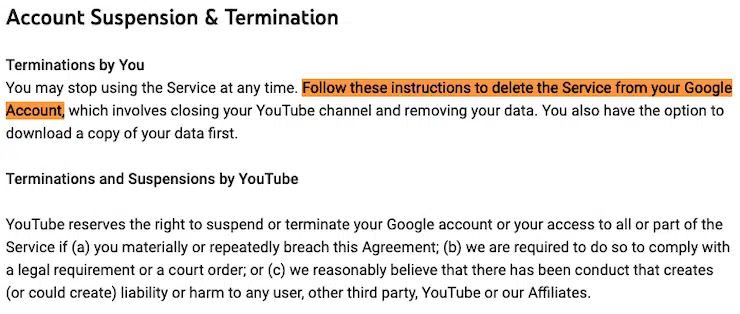
Property Rights
If you own a business, you probably have intellectual property that you want to protect. Put a clause in your terms of service that lists all property your business trademarks or other relevant copyright examples, like:
- Designs
- Videos
- Images
- Names
- Logos
- Patents
Then inform your users about any restrictions that apply to outside parties who want to use those materials.
Below, see a sample terms of service property rights clause from Slack that is well-written and easy to understand.
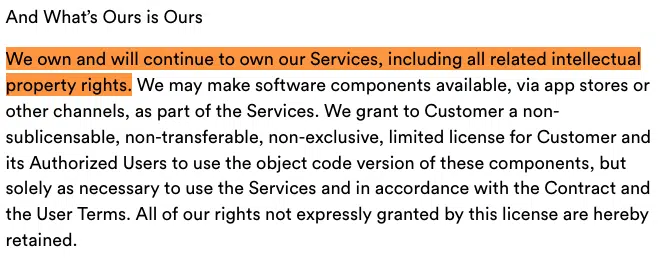
Products and Promotional Information
Your product and promotional information clause can help prevent your company from being held liable for any inconsistencies or discrepancies posted on your app or website.
For example, you can inform your users that product descriptions, information, and pricing online may not always be up to date and are subject to change without notice. You can also stipulate within this clause that your company reserves the right to end or refuse promotions, including discount codes, at any time.
Below, see a sample terms of service from Green Chef to learn how they phrase the fact that they reserve the right to adjust or replace meal kit ingredients without notice.

Payments and Pricing
Your terms of service is a great place for you to tell your users about your payment policies.
Try to be as thorough as possible and inform your users about:
- The methods of payments you accept
- What happens if they miss a payment
- The types of currency you take
If you want more tips to help you get the most out of this clause, check out our guide on how to write payment terms.
Below is another sample terms of service clause from Green Chef. Look at the highlighted text to see how they respond to missed payments.

User Contributions
If your website or app allows users to contribute content, you should include a clause within your terms of service so people know what they’re allowed to post and who has the rights to it.
The example terms of service shown below comes from YouTube, and the highlighted text explains what rights their users retain over the content they upload to the video-sharing platform.
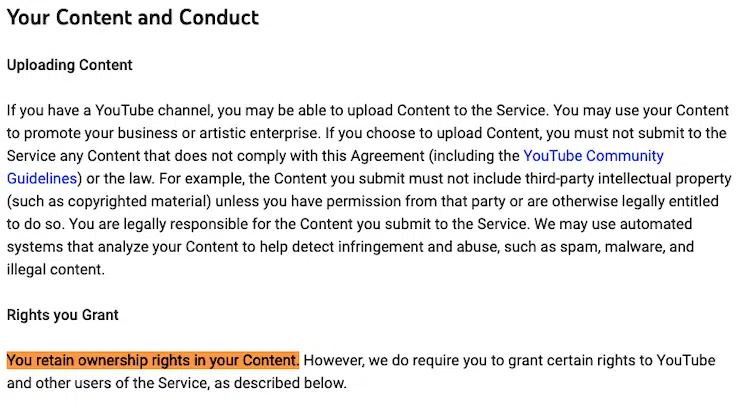
Limitation of Liability
If anything ever happens on your website or app, including a liability disclaimer in your terms of service may help remove some responsibilities from your business.
It’s essentially a statement from your business denying responsibility for any damages your users might suffer from accessing your services. It may also tell users what they cannot sue you for.
In the example below, read how Slack communicates their liability limitations in their terms of service.
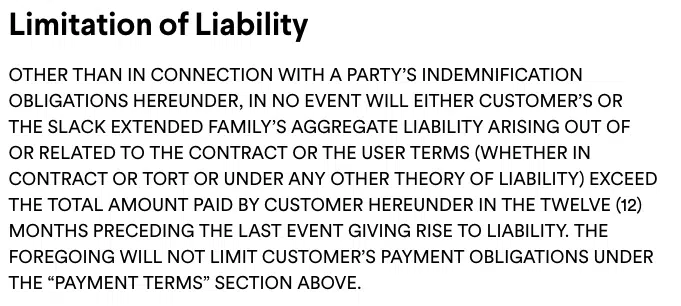
Privacy Agreements
You should link to other policies and legal agreements you want your users to access within your terms of service, including your privacy policy.
In the example below, notice how the Washington Post directly embeds a link to their privacy policy in their short, succinct privacy clause.

But if your business falls under the jurisdiction of data privacy laws like the General Data Protection Regulation (GDPR) or the California Consumer Privacy Act (CCPA), you must meet additional legal requirements, so make sure you’re familiar with the regulations that apply to your business.
Third-party Links
If you link to any external sources on your website or app, you can use a third-party links clause to express that your company is not liable for the content that might appear on those pages.
The highlighted text below from YouTube’s terms of service is a great example of how you might phrase your third-party links clause.

Amendments and Changes to the Agreement
A terms of service agreement is supposed to be a flexible document that adapts with your business. You should establish a process for how you will update your users about any changes you make to your policy.
Many companies include the last updated date near the header of their terms of service, and you should too.
But you can also include a short clause setting your users’ expectations, like how YouTube does it in the screenshot below.

Governing Law or Dispute Resolution
A governing law or dispute resolution clause lets users know how your service plans to handle conflicts or controversies relating to your terms of service.
The three most common ways you might handle disputes are:
- In court
- Binding arbitration
- Informal negotiations
If you choose to settle disputes in court, outline which courts will handle the case, the location of the court, and any governing laws that apply.
For binding arbitration, a mediator settles the dispute. Say where the arbitration will take place, how fees are handled, what the general process will look like, and what laws may apply.
If you choose informal negotiations, mention the timeline for the talks and outline what the process will look like.
In the example clause below from Green Chef, you can read how they primarily use binding arbitration but also list some exceptions.

Links to Your Other Policies
You should also include links to other relevant customer service policies in this clause if your business primarily sells goods that you ship to users.
For example, if your business uses any of the following policies, link to them in your ToS:
- Return and refund policy
- Shipping policy
- All sales final policy
- No refunds policy
- Money back guarantee
Company Contact Information
It’s in your best interest to include accurate contact information at the end of your terms of service agreement so your users know how to reach you if they have questions, comments, or concerns.
The example below shows the company contact clause in the terms of service from Snapchat.

Where To Display Your Terms of Service
You should post your terms of service agreement in multiple spots throughout your website or app, including your:
- Website footer
- Payment screens
- New user sign-up pages
- Privacy center
Let’s go over these common places to link to a ToS agreement in a little more detail.
Your Website Footer
The most common place to link to your terms of service is the footer of your website. By putting a link to your ToS in the footer, your users always have access to the policy, no matter what part of your website they end up on.
The screenshot below shows the footer from Squarespace’s website, which links to their terms of service under the ‘Company’ section.

Payment Screens
Payment screens are another great place to include a link to your terms of service because it gives your new and returning customers a chance to read the guidelines they’re expected to follow if they choose to make a purchase.
Below, you can see how the Washington Post puts a link to their terms of service on their payment page for a new subscription.
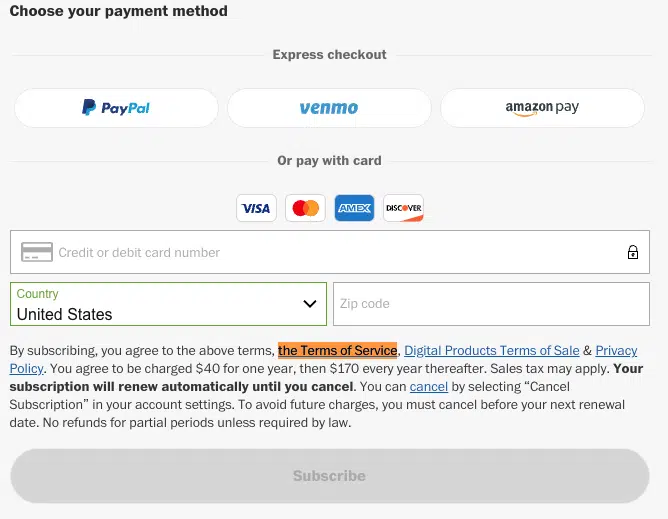
Account Creation or New Profile Pages
If your website or app allows users to create a profile or account, consider putting a link to your terms of service on a new user page so they know the rules before joining your service.
The highlighted text shown below from Green Chef’s new user profile signup page links directly to their terms of service.
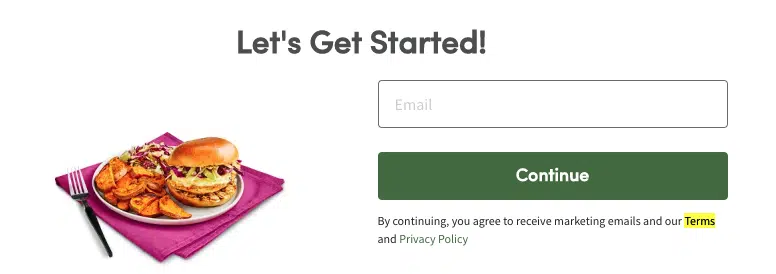
Your Privacy Center
A privacy center is a central hub that you can host on your website and share links to all legal agreements, privacy documents, policies, and procedures you want your users to access, including your terms of service.
If you don’t already have one on your website, check out our article covering all you need to know about privacy centers for tips on making your own.
Afterward, link to your privacy center in your website footer, like the highlighted example below from Facebook.

How to Enforce Your Terms of Service Agreement
To ensure you can enforce your ToS agreement, you’ll need to get consent from your users, which you can do in the two ways we cover below.
Clickwrap Method of Consent
One way to get consent for your terms of service agreement is to ask your users to select a checkbox to show that they’ve read and agree to the policy, known as the clickwrap method for consent.
See the highlighted text below for an example of how AARP uses the clickwrap method for consent to their terms of service whenever a new user signs up as a member.
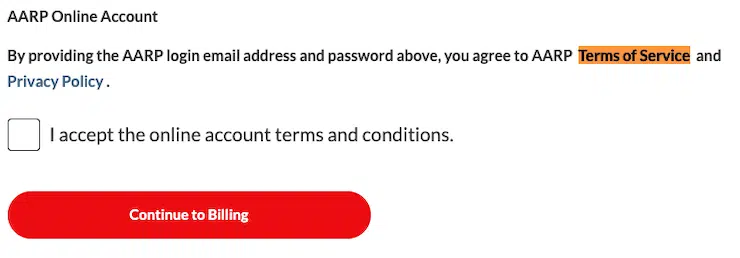
Asking your users to select a check box expressing they’ve read and accepted your terms of service is a great way to ensure your ToS policy is enforceable and is more likely to be upheld in court.
Implied Consent or Browsewrap Method
Another common way to enforce your terms of service is to use implied consent or browsewrap, which means your users agree to your terms by taking an action, like using your website or signing up for a profile.
See an example of browsewrap consent in the highlighted text below from Pinterest’s terms of service.
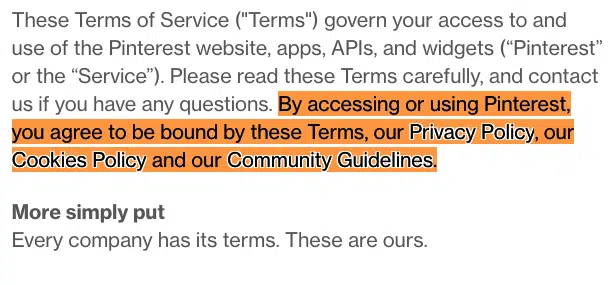
While implied consent works fine for most users, it can be tricky to hold up in court because your users can claim they did not know they agreed to anything by using your website or app.
We recommend you use both clickwrap and browsewrap methods of consent for your terms of service agreement to protect your business best.
Terms of Service Examples
In the next section, we look at some examples of terms of services from larger companies to help inspire you when you make your own ToS agreement.
Pinterest’s Terms of Service
Your terms of service should be written and formatted in a way that’s easy for your users to read and understand.
We recommend looking at Pinterest’s terms of service agreement below, which includes links to other relevant policies at the top of their document formatted as eye-catching circles and has helpful ‘More simply put’ summaries at the end of most clauses.
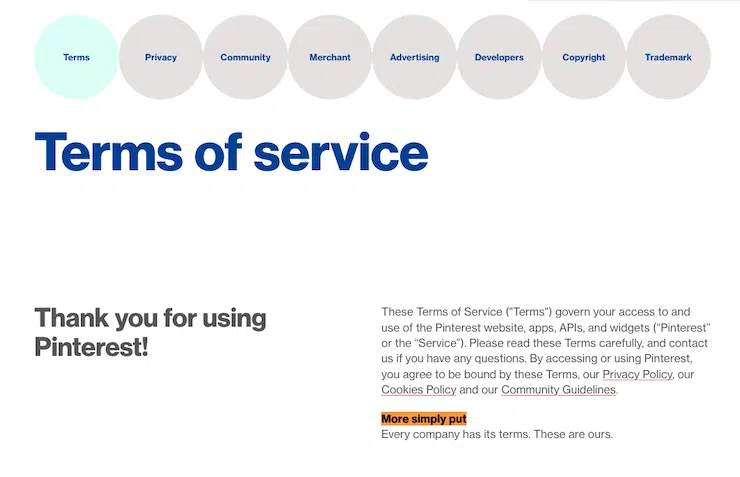
Like Pinterest, you might consider using a more conversational tone throughout your terms of service to make it more approachable for your users.
Below, read how Pinterest simplifies their warranty clause for their users, which is a nice touch since this clause usually contains a lot of legalese.
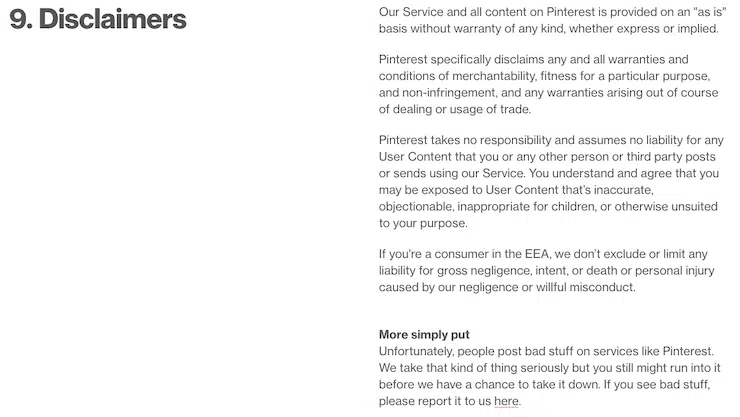
We also like how Pinterest consistently embeds relevant links for users throughout their entire policy and recommend you do the same in your own ToS agreement.
Slack’s Terms of Service
Your business might require a more complex terms of service agreement with clauses and amendments that you can separate into independently shareable documents.
Look at the highlighted text below from Slack’s terms of service page for an example, which has links to a second ToS policy, one is for their customers and the other is for users who were invited into a workspace.

Slack is also a great example of a company that separates their acceptable use clause into its own document, which they very clearly describe in the highlighted text below.
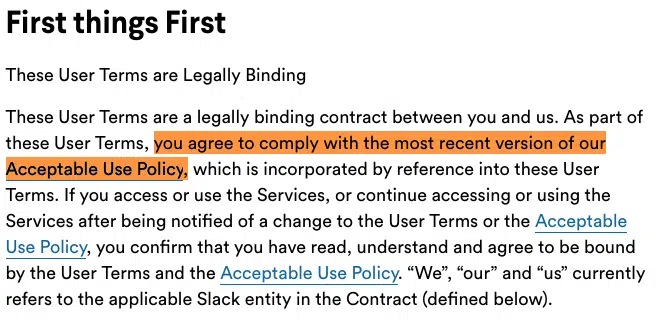
Like Slack, you can customize and format your terms of service agreement in whatever way you require so that it meets the unique needs of your business.
You can start by downloading our free terms of service template, which we designed to be seamlessly adaptable.
Tips for a Having a Good Terms of Service
Let’s go over a few easy tips you can follow to make a high-quality terms of service agreement for your website or app.
Make Your Terms of Service Easy to Read
Your terms of service is a legally binding contract, so you want to ensure it’s written in a way most users can understand.
Just ask Mark Zuckerberg, who was criticized by a senator during a 2018 joint hearing of the Senate Judiciary and Commerce committees because Facebook’s ToS at the time was not written in language the average American would understand, according to CNBC.
Since then, Facebook has made several updates to its terms to make them much more straightforward. The tech giant’s current terms of service are written in a consumer-friendly voice and have a clear table of contents for users to navigate.
You should also try to avoid long walls of text and unnecessary legal jargon wherever possible. In clauses where you can’t avoid legalese, like your limit of liability clause, consider simplifying the information using a brief summary, like the Pinterest examples above.
Include Clauses Relevant to Your Business
We’ve said it before, but terms of service agreements can vary drastically depending on the type of business you do.
For example, if your users can post comments and content on your platform, you’ll need a content and contributions clause outlining the rules you expect them to follow in your ToS. But if your platform does not allow for any user-generated content, this clause may not be applicable.
Pick and choose the clauses most relevant to your company, and be sure you’re extra thorough so you don’t accidentally leave something out.
Don’t Plagiarize Someone Else’s Terms of Service
No matter what you do, don’t copy and paste someone else’s terms or service agreement. Not only is this plagiarism, but legal documents are copyrighted materials.
Remember, the details within ToS policies change drastically from one company to the next, so if you do copy someone else’s agreement, it won’t cover all rules and guidelines that your business requires.
It’s not worth the risk, just use our free terms of service template instead.
Why Use a Terms of Service Template?
Making your own terms of service agreement can be a daunting process. A terms of service template is a great resource for business owners like you because it completes some of the initial leg work for you.
Rather than starting entirely from scratch, templates like ours outline common clauses and provide you with part of the actual text for each section.
Our terms of service template is very thorough, which can help prevent you from leaving out important items. But it’s also designed to be easy to read, which is ideal for your users.
General Terms of Service Template [Example Text and Download]
You can download our free terms of service template below in Word Doc, PDF, or Google Doc format. You can also just copy & paste the HTML directly to your website.
Before using it, read through the entire terms of service template – fill in all of the [brackets], remove any sections that do not apply to your app, and tweak any language as needed.
Additional Template Download Options
Our standard terms of service template can be used for the following platforms:
- Website
- Mobile App
- Software as a Service (SaaS)
- Blog
- Online Store
Terms of Service FAQ
In the next section, we took the time to answer some of the most frequently asked questions we get about terms of service agreements.
What is a terms of service agreement?
A terms of service agreement outlines all rules of use your customers must follow when using your services, it helps limit liabilities from falling onto your company, and it establishes your property rights.
A terms of service agreement might also be called:
- Terms of use
- Terms and conditions
Do I need a terms of service for my website?
Yes, you should have a terms of service for your website to help set customer rules and expectations, resolve conflicts, establish property rights, and take some legal liabilities off your business.
Do I need a terms of service for my app?
Yes, you should have a terms of service for your app to help establish the rules and expectations for your customers, claim your property rights, resolve potential conflicts, and limit the legal liabilities that fall onto your business.
What clauses should every terms of service include?
Your terms of service should include some or all of the following clauses, but you can also adapt the agreement to fit whatever your business requires:
- Introduction
- Prohibited or acceptable uses
- Account Termination and Suspension
- Property Rights
- Products and Promotional Information
- Payments and Pricing
- User Contributions
- Limitation of Liability
- Privacy Agreements
- Third-party Links
- Amendments and Changes to the Agreement
- Governing Law or Dispute Resolution
- Company Contact Information
Summary
If you own a website or app, you should post a terms of service in multiple locations so your users are always aware of the guidelines they’re expected to follow when using your services.
A standard terms of service agreement also helps limit liabilities from falling onto your business and allows you to establish and maintain your intellectual property rights.
If you don’t already have a ToS agreement posted on your website or app, there’s no need to wait. Download our free terms of service template and customize it to fit your unique business needs.

